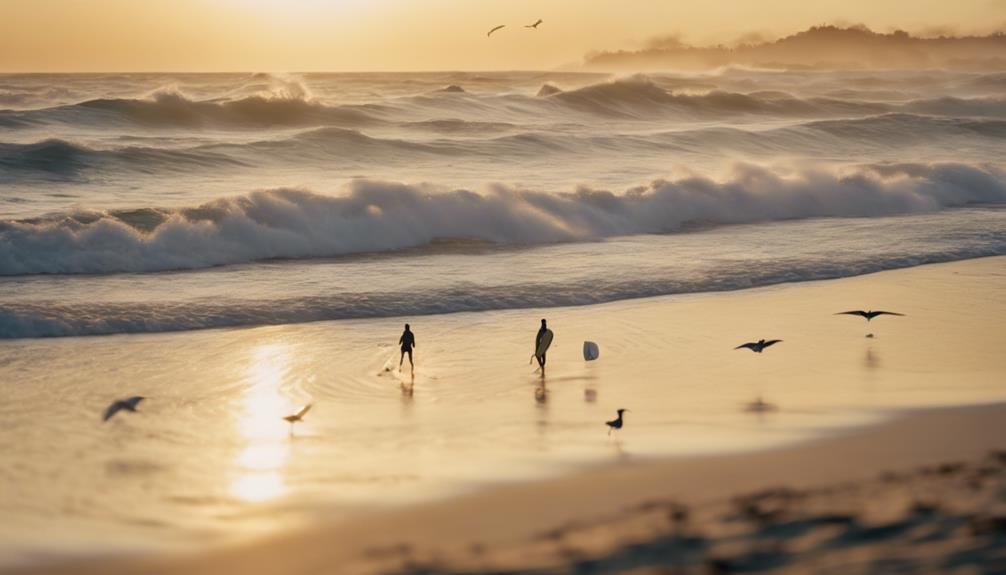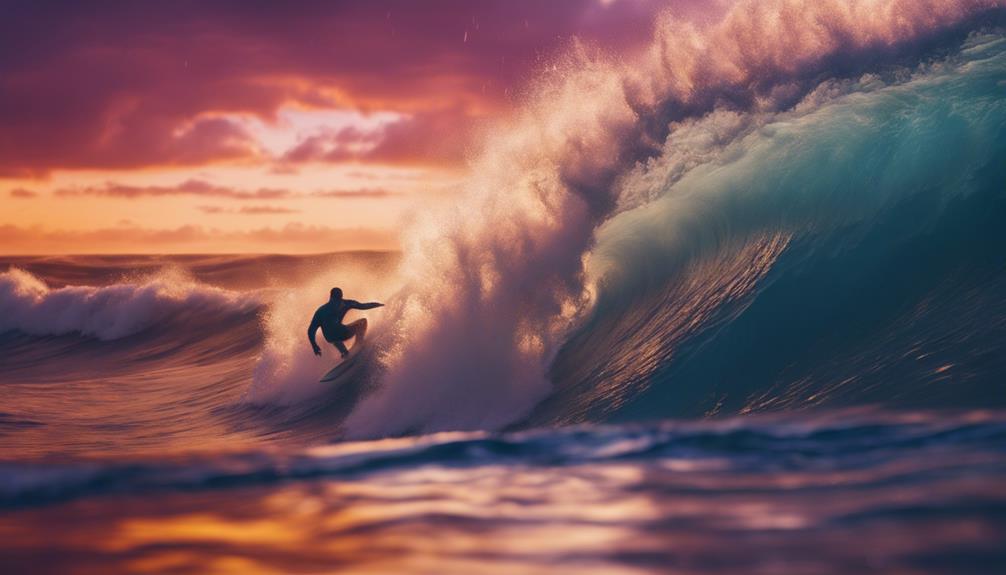Surfing waves are formed through the transfer of wind energy to the ocean's surface. When wind blows over water, it creates ripples that grow into larger waves, influenced by wind speed, direction, and fetch. As waves travel, their energy remains mostly intact until they reach the shore, where they break and release energy, creating surf. Factors like storm proximity, ocean floor topography, and weather conditions further shape wave behavior and size. Understanding these elements helps you catch better waves. There's much more to explore about the dynamics of waves and how they can enhance your surfing experience.
Key Takeaways
- Surfing waves are primarily caused by wind energy transferring to the ocean surface, starting with small capillary waves.
- Wave size and shape depend on wind strength, direction, and the distance over which the wind blows (fetch).
- As waves approach the shore, they slow down and increase in height due to interaction with the ocean floor.
- Energy from breaking waves disperses upon reaching the shore, creating powerful forces that shape the beach.
Wave Formation Process
Waves form when wind transfers energy to the ocean surface, beginning with small capillary waves that grow into larger gravity waves as wind strength and duration increase. As the wind blows across the water, it creates a disturbance, and this is where wave formation starts. The size and shape of these waves depend on various factors, like wind speed, wind direction, and fetch—the distance the wind travels over the water.
As these waves travel, they carry wave energy through the ocean, but it's crucial to note that water particles move in circular orbits rather than following the wave itself. This unique motion helps maintain the energy's integrity as it moves across the surface.
When these waves encounter the ocean floor, particularly in shallower areas, their behavior changes due to topographical influences. You might notice different types of waves, such as spilling, plunging, and surging waves, based on the underwater landscape.
The process culminates in breaking waves, which happen when the wave height surpasses a critical ratio to the wavelength, transforming wave energy into turbulent kinetic energy as the wave crashes.
Energy Transfer Mechanisms
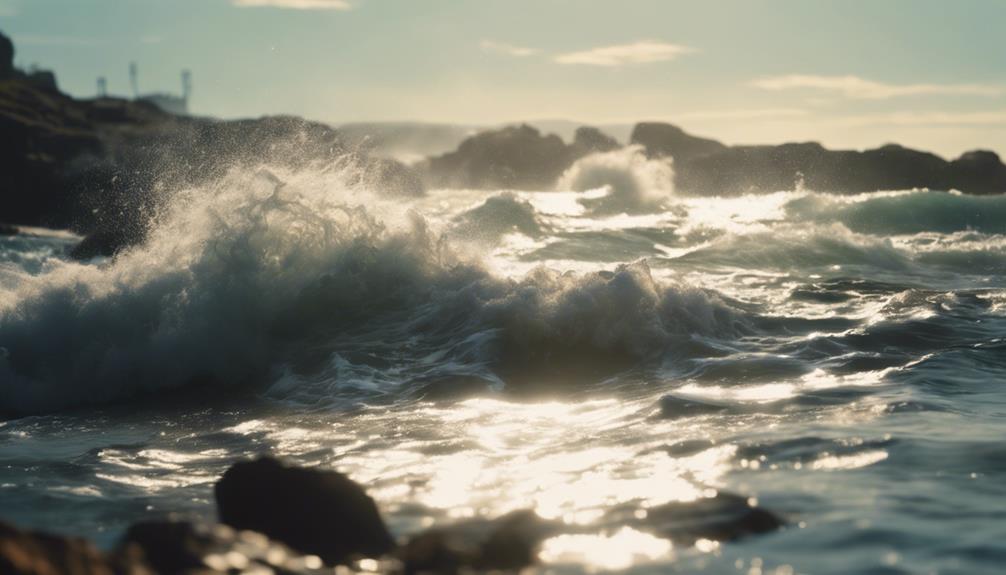
When you catch a wave, you're experiencing the energy transfer that starts far out at sea.
This energy moves through the water, following the principle of energy conservation, before reaching the shore and dispersing.
Understanding how wave propagation and shoreline energy dispersion work can enhance your surfing experience.
Energy Conservation Principle
The energy conservation principle explains how energy moves through water, emphasizing that energy can only be transferred, not created or destroyed. When wind blows across the ocean, it creates friction that transfers energy, giving rise to initial ripples known as capillary waves.
These ripples develop into larger gravity waves, which carry wave energy across vast distances. As the energy travels through the water, the water itself remains largely in place, illustrating that it's energy that's moving, not the water.
When these waves approach the shore, they begin to lose energy. This energy dissipates as the waves break, transferring their energy to the beach.
For surfers, understanding this energy transfer is essential, as it determines the quality of the waves they ride. The organization and size of the waves depend considerably on their distance from the storm that generated them; longer distances typically yield better wave organization due to more effective energy transfer.
Wave Propagation Process
Understanding how energy moves through water helps clarify the wave propagation process, where energy travels across the ocean while the water itself stays mostly still. Waves start when wind energy transfers to the water surface, creating ripples that can grow into larger waves.
The following table highlights the different types of waves and their characteristics:
| Wave Type | Energy Source | Characteristics |
|---|---|---|
| Wind Waves | Wind | Short wavelength, less organized |
| Swell Waves | Wind (long fetch) | Longer wavelength, more organized |
| Tsunami Waves | Seismic Activity | Very long wavelength, high energy |
| Capillary Waves | Surface Tension | Small, short-lived ripples |
As energy moves through the water, it transforms based on the wind's strength, duration, and fetch. This dynamic interaction influences the size and organization of waves. Remember, the Law of Conservation of Energy means that energy in waves can't be created or destroyed but is transferred, affecting how waves behave in different depths. Understanding these mechanisms is essential for grasping how waves travel and break along coastlines.
Shoreline Energy Dispersion
As waves approach the shore, their energy disperses, causing them to break and release powerful forces onto the beach. This energy dispersion is essential for surfers, as it determines the quality of the waves they ride.
When waves travel long distances from their storm origins, they become more organized and powerful. However, as they enter shallow waters, their speed decreases, and their height increases, ultimately leading to dramatic wave breaks.
The interaction between the waves and the ocean floor plays a significant role in this transformation. The energy that once propels the wave forward is redirected, creating the surf you experience. You might notice how the foam and turbulence at the wave's crest signal its impending break, which is crucial for your surfing experience.
Understanding how energy disperses along the shoreline can help you predict wave behavior and choose the best moments to catch the perfect wave.
In essence, the process of energy dispersion not only shapes the waves but also directly impacts your ride, turning the ocean into an exhilarating playground for surfers.
Types of Surfing Waves
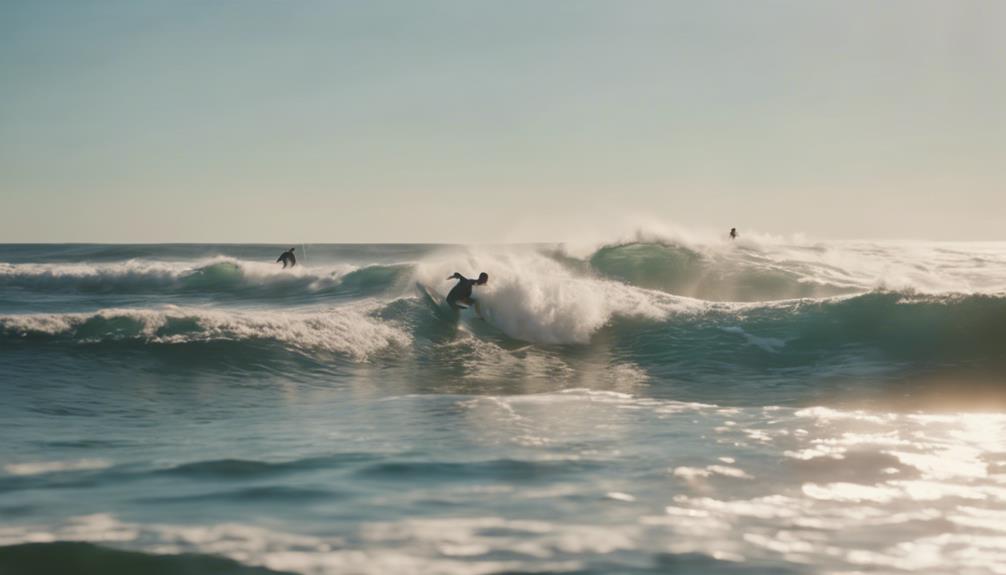
When you hit the waves, you'll encounter different types that cater to your skill level and preferences.
Spilling waves offer a gentle ride for beginners, while plunging waves give experienced surfers the thrill of barrels.
If you're looking for a real challenge, surging waves can test your abilities with their steep faces and powerful conditions.
Spilling Waves Characteristics
Spilling waves offer a gentle, smooth break, making them perfect for beginners looking to hone their surfing skills. These waves gradually spill over their crest, providing a more manageable experience for novice surfers. Typically found on gradual beach slopes, spilling waves maintain their shape as they rise, thanks to the ocean floor's gentle incline.
The energy of spilling waves is lower than that of other wave types, allowing you to ride them with ease and confidence. With a height-to-wavelength ratio of less than 1/7, these waves avoid steep breaks, ensuring a safer environment for learners. As a result, you can practice paddling, balancing, and turning without the intimidation of more powerful waves.
You'll find spilling waves at various surf spots worldwide, offering consistent and enjoyable conditions for surfers of all skill levels. Whether you're catching your first wave or refining your technique, these waves provide an ideal setting. Embrace the thrill of riding spilling waves, and before you know it, you'll be ready to tackle more challenging surf conditions.
Plunging Waves Dynamics
Plunging waves deliver an exhilarating challenge, with their steep faces collapsing into powerful barrels that experienced surfers crave. These waves typically break on steep ocean floors, causing the depth to decrease sharply and leading to a rapid increase in wave height as they approach the shore. This dynamic creates a thrilling ride that's perfect for those who seek adventure.
With a height-to-wavelength ratio exceeding the critical 1/7 threshold, plunging waves showcase dramatic breaking action. The energy concentration in these waves allows for faster rides, making them a favorite among surfers for executing tricks and maneuvers. The well-defined peak of plunging waves creates a specific breaking point, enabling you to strategically position yourself for the best experience possible.
When you're riding a plunging wave, you'll feel the rush as you navigate the barrel, utilizing both your skill and the wave's power to enhance your performance. Understanding the dynamics of plunging waves not only boosts your surfing game but also deepens your appreciation for the ocean's natural forces.
Surging Waves Features
Surging waves offer a distinct surfing experience with their steep, unbroken faces that create thrilling conditions for advanced surfers. These waves typically don't break until they reach the shore, allowing you to enjoy long, smooth rides if you know how to navigate them. Surging waves often form in deep water, and their behavior is heavily influenced by the ocean floor's topography.
Unlike spilling or plunging waves, surging waves maintain their energy, resulting in fast, exhilarating rides without the conventional breaking motion. This unique characteristic can make them unpredictable, which adds to the excitement. The height and power of surging waves can vary considerably based on wind conditions and the seabed beneath them, so it's crucial to stay alert while surfing.
For advanced surfers, mastering surging waves can enhance your skills and boost your confidence. Understanding how the ocean floor and wind interact to shape these waves will help you anticipate their movements better.
Influencing Factors for Wave Size

Wind strength is a key factor that directly impacts wave size, as stronger winds transfer more energy to the surface of the water. When the wind blows vigorously, it creates larger waves by pushing water molecules together and generating turbulence.
However, wind strength isn't the only factor at play. Here are some additional influences you should consider:
- Fetch: The distance over which the wind blows; longer fetches allow waves to develop more energy.
- Storm Proximity: Closer storms can generate chaotic waves, while distant storms lead to more organized swells.
- Gravitational Forces: As waves approach shallower waters, the pull of gravity can increase their height.
- Swell Period: The time between successive wave crests; longer periods usually produce more powerful waves.
Understanding these factors will help you predict wave size and improve your surfing experience.
Ocean Dynamics and Surf Conditions

Understanding ocean dynamics is essential for surfers looking to optimize their time on the waves, as various factors like currents and tides greatly influence surf conditions.
Ocean currents, driven by wind and temperature differences, can either enhance or diminish your surfing opportunities. By familiarizing yourself with these currents, you can catch waves more efficiently and steer clear of dangerous situations, like rip currents.
Tidal patterns also play a significant role in shaping surf conditions. The gravitational pull of the moon and sun creates cycles that affect the water level, meaning the timing of your surf sessions is critical. Knowing when to hit the water according to tide stages can lead to better wave formation, allowing you to enjoy more consistent and high-quality breaks.
Moreover, the interaction of tides with seafloor topography impacts how waves form. Different surf spots can behave uniquely depending on these dynamics, so it's worth exploring various locations.
Weather Impact on Waves
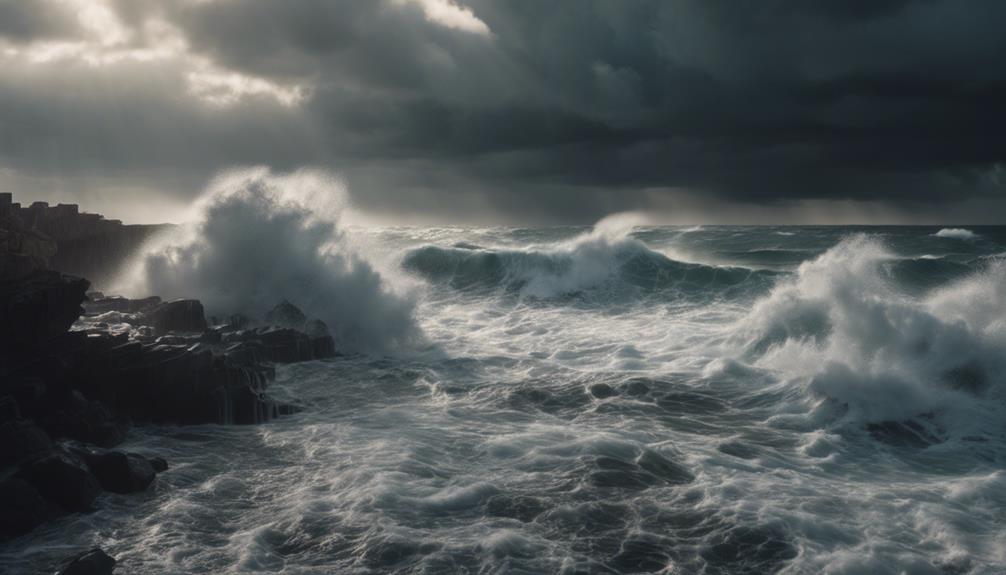
When weather conditions align, the ocean can transform, producing waves that range from playful ripples to powerful surges ideal for surfing. The interaction between wind strength and the ocean surface is key; as wind blows, it transfers energy to the water, and that's how waves are formed. Stronger winds that last longer generate larger, more formidable waves.
Understanding weather patterns is essential for surfers. Low-pressure systems often indicate potential swell development, resulting in significant wave activity.
Here are some factors to take into account:
- Wind strength: Stronger winds create bigger waves.
- Wind duration: Longer-lasting winds increase wave energy.
- Local vs. distant storms: Localized winds produce choppy wind swells, while distant storms yield smoother ground swells.
- Weather forecasting: Predicting swells requires knowledge of upcoming weather changes.
Ocean Floor and Wave Behavior

Exploring the ocean floor's topography reveals how it shapes wave behavior, dramatically affecting your surfing experience. Features like sandbars and reefs play an essential role in determining how surfing waves form and break.
When you paddle out, you'll notice that shallow areas prompt waves to break earlier and more dramatically, creating steeper faces and powerful breaks that can enhance your ride.
Wave refraction is another fascinating aspect of wave behavior; as waves bend and change direction due to varying ocean floor depths, they can create ideal surfing conditions at certain spots along the coast. Generally, a wave breaks at about 1.3 times its height, meaning deeper waves can travel farther before breaking, which can greatly impact the quality of your surf session.
Additionally, the composition of the ocean floor matters. Rocky bottoms often yield plunging waves, while sandy bottoms typically produce spilling waves. This diversity in wave types means that your experience can vary greatly from one surf spot to another.
Understanding the ocean floor's influence on wave behavior can help you choose the best locations for an unforgettable surfing adventure.
Frequently Asked Questions
What Causes Surfing Waves?
Surfing waves form when wind energy transfers to the ocean, creating ripples that grow into larger waves. Factors like wind strength, duration, and distance traveled influence their size and surf conditions you'll experience.
What Causes the Formation of Surf?
You might think surf just magically appears, but it's really wind energy transforming the ocean's surface. As winds blow, ripples grow into waves, shaped by distance, depth, and the ocean floor's unique contours.
What Causes the Big Waves at Nazaré?
The big waves at Nazaré occur due to underwater canyons that funnel swells from distant storms. This unique ocean floor topography, combined with local winds, creates massive waves that can exceed 80 feet during peak conditions.
What Caused the Huge Waves in California?
California's waves rise like giants from the deep, powered by North Pacific storms. Those storms churn the ocean, while local winds shape the swells, creating perfect conditions for your next thrilling surf adventure.
What Causes Some Surfing Waves to be More Dangerous Than Others?
Some of the most dangerous surfing waves can be caused by a combination of factors such as the shape of the ocean floor, the direction of the wind, and the size of the waves. When these elements come together, they can create waves that are much more powerful and unpredictable, making them more hazardous for surfers.
Conclusion
In the end, surfing waves are like nature's whispers, each one carrying stories from distant storms and the ocean floor's secrets.
By understanding the forces at play—from energy transfer to weather impacts—you reveal the mysteries behind those thrilling rides.
Just as a surfer reads the rhythm of the sea, you learn to appreciate the beauty and power of the waves.
So, the next time you paddle out, remember: every wave is a moment waiting to be explored.

